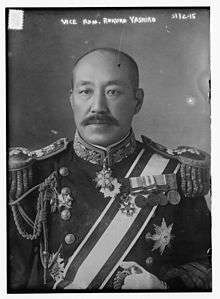Yashiro Rokurō
| Baron Yashiro Rokurō | |
|---|---|
 Rokurō circa 1915 | |
| Native name | 八代 六郎 |
| Born |
January 3, 1860 Inuyama, Owari Province, Japan |
| Died |
June 30, 1930 (aged 70)[1] Japan |
| Allegiance | Empire of Japan |
| Service/branch |
|
| Years of service | 1881–1925 |
| Rank | Admiral |
| Commands held | |
| Battles/wars | |
| Other work |
Navy Minister Privy Council (Japan) |
Baron Yashiro Rokurō (八代 六郎, 3 January 1860 – 30 June 1930) was an admiral in the Imperial Japanese Navy and Navy Minister, succeeding the last of the Satsuma-era naval leaders of the early Meiji period.
Biography
Born in the Inuyama domain, Owari Province (present day Aichi prefecture), Yashiro graduated from the 8th class of the Imperial Japanese Naval Academy in 1881. He was ranked 19th of his class of 35 cadets. After midshipman service in the ironclad warship Ryūjō, he served as a crewman on the corvette Tsukuba. He was the posted to various administrative assignments within the Imperial Japanese Naval Academy. From July 1890 to November 1892, he was sent as a naval attaché to Vladivostok, in Russia.
After his return to Japan, he was assigned to the cruiser Takachiho, and was serving as a division officer aboard that vessel during the Battle of the Yalu on 17 September 1894 in the First Sino-Japanese War. Yashiro briefly served on the cruiser Yoshino during the next year, before being assigned as a naval attaché to Saint Petersburg, Russia.
Promoted to lieutenant commander in 1896 and commander the following year, Yashiro served on the Imperial Japanese Navy General Staff between 1899 and 1900. In early 1900, he was appointed the executive officer on the cruiser Yashima, and in late 1900, he received his first command: the cruiser Miyako, followed by the Izumi.
Following his graduation from the Naval Staff College, Yashiro was promoted to captain in 1901. Commander of the armored cruiser Azuma during the Russo-Japanese War, Yashiro earned a reputation as a cool-headed and intelligent battle commander in skirmishes against the Russian cruiser Varyag and the gunboat Korietz in the Battle of Chemulpo Bay on 9 February 1904 as well as taking part in the Battle of the Yellow Sea and the Battle of Tsushima.
At the war's end, Yashiro was assigned to Berlin, Germany as naval attaché until 1907, when he was promoted to rear admiral, serving as commander of a number of naval bases and fleets between 1907 and 1911. On 1 December 1911, he became Commandant of the Naval War College. During his time at the War College, Yashiro was a strong proponent of introducing karate into the Navy's training program.
On 25 September 1913, he was transferred to become Commander in Chief of the Maizuru Naval District.
Following the Siemens-Vickers scandals, Yashiro replaced Admiral Yamamoto Gonnohyoe as Navy Minister. Although appointed due to his commendable military and apolitical record, Yashiro's bluntness and dealing directly with politicians led to his forced resignation in April 1915. Commanding the IJN 2nd Fleet until 1917, Yashiro was then given command of the Sasebo Naval District.
Yashiro was ennobled with the title of danshaku (baron) under the kazoku peerage system in 1916. Raised to the rank of full admiral in 1918, Yashiro was placed on the inactive list in 1919 and lived in retirement until his death in 1930.
References
Books
- Dupuy, Trevor N. (1992). Encyclopedia of Military Biography. I B Tauris & Co Ltd. ISBN 1-85043-569-3.
External links
- Nishida, Hiroshi. "Materials of IJN: Yashiro, Rokuro". Imperial Japanese Navy. Retrieved 2007-09-03.
Notes
- ↑ Nishida, Imperial Japanese Navy
| Military offices | ||
|---|---|---|
| Preceded by Saitō Makoto |
Minister of the Navy 16 April 1914 – 8 October 1915 |
Succeeded by Katō Tomosaburō |